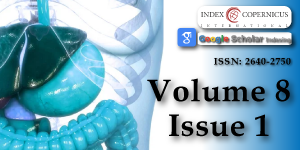Reliability and Diagnostic Performance of Transient Hepatic Elastography in Chronic Hepatitis C during the Training Phase
Main Article Content
Abstract
Chronic infection with the hepatitis C virus (HCV) is estimated to affect 58 million people worldwide and around 700,000 individuals in Brazil. Various non-invasive markers of hepatic fibrosis have been proposed, such as transient hepatic elastography (THE) using FibroScan®. However, the reliability of the performance, by operators in the training phase is undetermined, which hinders its applicability in clinical practice.
Objectives: The present study aimed to evaluate the impact of training an inexperienced operator to perform the examinations using FibroScan® in patients with chronic hepatitis C. Specifically, the frequency of unreliable results throughout the training was assessed.
Methods: This is a cross-sectional study with retrospective data collection including compensated chronic hepatitis C patients who underwent the examinations using FibroScan® between March 2014 and December 2016, performed by two researchers. Included patients were divided into two groups based on the operator's experience in the examination: the Experienced Examiner (EE) group and the Examiner in Training (ET) group, with the latter divided into two phases: phase 1, consisting of the first 100 examinations, and phase 2, comprising subsequent examinations. For the reliability analysis, parameters such as success rate (SR), interquartile range (IQR) to median (Md) ratio (IQR/Md), and reliability criteria of Castéra, et al. and Boursier, et al. were used.
Results: Between March 2014 and December 2016, 771 adult HCV-infected individuals were evaluated and divided into EE group (n = 161), ET phase 1 (n = 100), and ET phase 2 (n = 158), showing similar demographic, clinical, and laboratory characteristics. SR and IQR/Md ratios were similar among EE, ET phase 1, and ET phase 2 groups. The proportion of reliable results was comparable in all three groups, using Castéra, et al. reliability criteria (92.5%, 92.0%, and 97.5%, respectively) and Boursier, et al. criteria (96.9%, 95.0%, and 98.1%, respectively).
Conclusion: A short training period (up to 100 examinations) seems to be sufficient for them to have good clinical applicability in the hands of an operator with initial experience in the method.
Article Details
Copyright (c) 2024 Appel F, et al.

This work is licensed under a Creative Commons Attribution 4.0 International License.
European Association for the Study of the Liver. EASL Recommendations on Treatment of Hepatitis C 2018. J Hepatol 2018;69(2):461-511.Available from: https://pubmed.ncbi.nlm.nih.gov/29650333/
Brasil Ministério da Saúde. Secretaria de Vigilância em Saúde. Departamento de DST, Aids e Hepatites Virais. Protocolo Clínico e Diretrizes Terapêuticas para Hepatite C e Coinfecções/ Ministério da Saúde, Secretaria de Vigilância em Saúde, Departamento de DST, Aids e Hepatites Virais. – Brasília: Ministério da Saúde, 2019.
Shen Q, Zhang J, Yang S, Liu L. A comparative study of three ultrasound techniques for liver fibrosis staging. Eur J Gastroenterol Hepatol. 2024 Jun 1;36(6):784-792. Available from: https://pubmed.ncbi.nlm.nih.gov/38526936/
European Association for the Study of the Liver; Asociación Latinoamericana para el Estudio del Hígado. EASL-ALEH Clinical Practice Guidelines: Non-invasive tests for evaluation of liver disease severity and prognosis. J Hepatol 2015;63(1):237-64. Available from: https://pubmed.ncbi.nlm.nih.gov/25911335/
Castera L, Vergniol J, Foucher J, Le Bail B, Chanteloup E, et al. Prospective comparison of transient elastography, Fibrotest, APRI, and liver biopsy for the assessment of fibrosis in chronic hepatitis C. Gastroenterology 2005;128(2):343-50.Available from: https://pubmed.ncbi.nlm.nih.gov/15685546/
Ziol M, Handra-Luca A, Kettaneh A, Christidis C, Mal F, et al. Noninvasive assessment of liver fibrosis by measurement of stiffness in patients with chronic hepatitis C. Hepatology 2005;41(1):48-54.Available from: https://pubmed.ncbi.nlm.nih.gov/15690481/
Child CG, Turcotte JG. Surgery and portal hypertension. Major Probl Clin Surg 1964;1:1-85.Available from: https://pubmed.ncbi.nlm.nih.gov/4950264/
Boursier J, Zarski JP, de Ledinghen V, Rousselet MC, Sturn N, et al. Determination of Reliability Criteria for Liver Stiffness Evaluation by Transient Elastography Hepatology 2013;57(3)1182-9. Available from: https://pubmed.ncbi.nlm.nih.gov/22899556/
Boursier J, Konate A, Guilluy M, Gorea G, Sawadogo A, et al. Learning curve and interobserver reproducibility evaluation of liver stiffness measurement by transient elastography. Eur J Gastroenterol Hepatol 2008;20(7):693-701.Available from: https://pubmed.ncbi.nlm.nih.gov/18679074/
Perazzo H, Fernandes FF, Soares JC, Fittipaldi J, Cardoso SW, et al. Learning curve and intra/interobserver agreement of transient elastography in chronic hepatitis C patients with or without HIV co-infection. Clin Res Hepatol Gastroenterol 2016;40(1):73-82.Available from: https://pubmed.ncbi.nlm.nih.gov/26056050/
Castera L, Foucher J, Bernard PH, Carvalho F, Allaix D, et al. Pitfalls of liver stiffness measurement: a 5-year prospective study of 13,369 examinations. Hepatology 2010;51(3):828-35. Available from: https://pubmed.ncbi.nlm.nih.gov/20063276/
Fraquelli M, Rigamonti C, Casazza G, Conte D, Donato MF, Ronchi G, Colombo M. Reproducibility of transient elastography in the evaluation of liver fibrosis in patients with chronic liver disease. Gut 2007;56(7):968-73.Available from: https://pubmed.ncbi.nlm.nih.gov/17255218/
Lucidarme D, Foucher J, Le Bail B, Vergniol J, Castera L, et al. Factors of the accuracy of transient elastography (fibroscan) for the diagnosis of liver fibrosis in chronic hepatitis C. Hepatology 2009;49(4):1083-9. Available from: https://pubmed.ncbi.nlm.nih.gov/19140221/
Anstee QM, Castera L, Loomba R. Impact of non-invasive biomarkers on hepatology practice: Past, present and future. J Hepatol. 2022 Jun;76(6):1362-1378.Available from: https://pubmed.ncbi.nlm.nih.gov/35589256/
Oeda S, Tanaka K, Oshima A, Matsumoto Y, Sueoka E, Takahashi H. Diagnostic Accuracy of FibroScan and Factors Affecting Measurements. Diagnostics (Basel). 2020 Nov 12;10(11):940. Available from: https://pubmed.ncbi.nlm.nih.gov/33198092/
Boursier J, Konaté A, Gorea G, Reaud S, Quemener E, et al. Reproducibility of liver stiffness measurement by ultrasonographic elastometry Clin Gastroenterol Hepatol 2008;6(11):1263-9. Available from: https://pubmed.ncbi.nlm.nih.gov/18995217/

